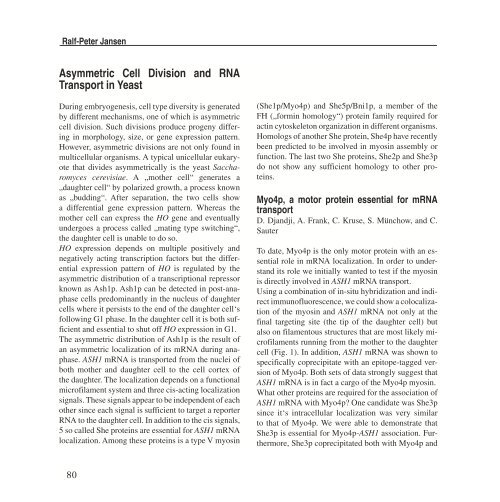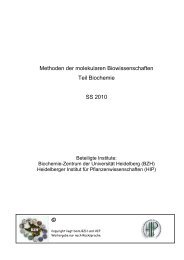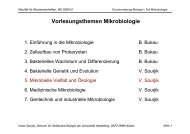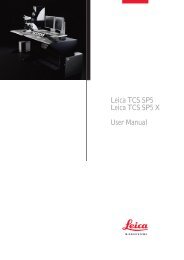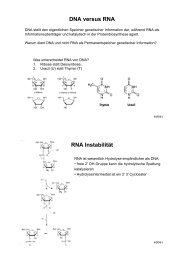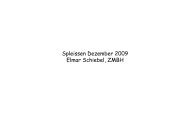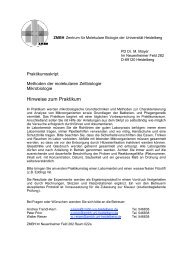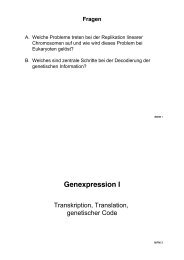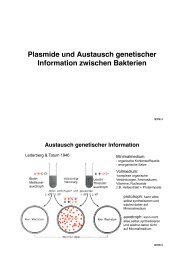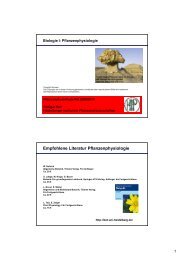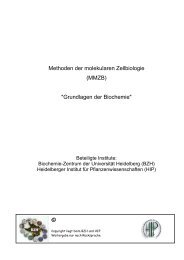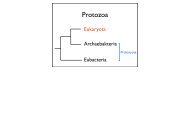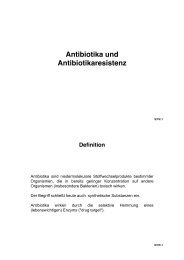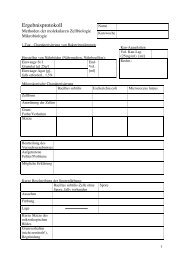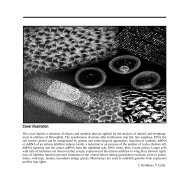ZMBH J.Bericht 2000 - Zentrum für Molekulare Biologie der ...
ZMBH J.Bericht 2000 - Zentrum für Molekulare Biologie der ...
ZMBH J.Bericht 2000 - Zentrum für Molekulare Biologie der ...
Create successful ePaper yourself
Turn your PDF publications into a flip-book with our unique Google optimized e-Paper software.
Ralf-Peter Jansen<br />
Asymmetric Cell Division and RNA<br />
Transport in Yeast<br />
During embryogenesis, cell type diversity is generated<br />
by different mechanisms, one of which is asymmetric<br />
cell division. Such divisions produce progeny differing<br />
in morphology, size, or gene expression pattern.<br />
However, asymmetric divisions are not only found in<br />
multicellular organisms. A typical unicellular eukaryote<br />
that divides asymmetrically is the yeast Saccharomyces<br />
cerevisiae. A „mother cell“ generates a<br />
„daughter cell“ by polarized growth, a process known<br />
as „budding“. After separation, the two cells show<br />
a differential gene expression pattern. Whereas the<br />
mother cell can express the HO gene and eventually<br />
un<strong>der</strong>goes a process called „mating type switching“,<br />
the daughter cell is unable to do so.<br />
HO expression depends on multiple positively and<br />
negatively acting transcription factors but the differential<br />
expression pattern of HO is regulated by the<br />
asymmetric distribution of a transcriptional repressor<br />
known as Ash1p. Ash1p can be detected in post-anaphase<br />
cells predominantly in the nucleus of daughter<br />
cells where it persists to the end of the daughter cell‘s<br />
following G1 phase. In the daughter cell it is both sufficient<br />
and essential to shut off HO expression in G1.<br />
The asymmetric distribution of Ash1p is the result of<br />
an asymmetric localization of its mRNA during anaphase.<br />
ASH1 mRNA is transported from the nuclei of<br />
both mother and daughter cell to the cell cortex of<br />
the daughter. The localization depends on a functional<br />
microfilament system and three cis-acting localization<br />
signals. These signals appear to be independent of each<br />
other since each signal is sufficient to target a reporter<br />
RNA to the daughter cell. In addition to the cis signals,<br />
5 so called She proteins are essential for ASH1 mRNA<br />
localization. Among these proteins is a type V myosin<br />
80<br />
(She1p/Myo4p) and She5p/Bni1p, a member of the<br />
FH („formin homology“) protein family required for<br />
actin cytoskeleton organization in different organisms.<br />
Homologs of another She protein, She4p have recently<br />
been predicted to be involved in myosin assembly or<br />
function. The last two She proteins, She2p and She3p<br />
do not show any sufficient homology to other proteins.<br />
Myo4p, a motor protein essential for mRNA<br />
transport<br />
D. Djandji, A. Frank, C. Kruse, S. Münchow, and C.<br />
Sauter<br />
To date, Myo4p is the only motor protein with an essential<br />
role in mRNA localization. In or<strong>der</strong> to un<strong>der</strong>stand<br />
its role we initially wanted to test if the myosin<br />
is directly involved in ASH1 mRNA transport.<br />
Using a combination of in-situ hybridization and indirect<br />
immunofluorescence, we could show a colocalization<br />
of the myosin and ASH1 mRNA not only at the<br />
final targeting site (the tip of the daughter cell) but<br />
also on filamentous structures that are most likely microfilaments<br />
running from the mother to the daughter<br />
cell (Fig. 1). In addition, ASH1 mRNA was shown to<br />
specifically coprecipitate with an epitope-tagged version<br />
of Myo4p. Both sets of data strongly suggest that<br />
ASH1 mRNA is in fact a cargo of the Myo4p myosin.<br />
What other proteins are required for the association of<br />
ASH1 mRNA with Myo4p? One candidate was She3p<br />
since it‘s intracellular localization was very similar<br />
to that of Myo4p. We were able to demonstrate that<br />
She3p is essential for Myo4p-ASH1 association. Furthermore,<br />
She3p coprecipitated both with Myo4p and<br />
Figure 1<br />
ASH1 mRNA. In addition, She3p‘s aminoterminus<br />
that is predicted to form a coiled coil can bind to<br />
the carboxyterminal tail of Myo4p in a two hybrid assay<br />
whereas She3p‘s carboxyterminus interacts with<br />
She2p. She3p and She2p might be adapters between<br />
the mRNA and the motor protein.<br />
The role of Myo4p‘s tail domain was further investigated<br />
since the tail domains of other myosins are<br />
involved in cargo binding. Expression of the tail in an<br />
otherwise wildtype cell had the effect of a dominant<br />
negative mutant. It abolished the localization of ASH1<br />
mRNA, She3p and endogenous Myo4p as well as the<br />
association of endogenous Myo4p with She3p, most<br />
likely by sequestering essential factors. The effects are<br />
specific since the expression of another type V myosin<br />
tail did not interfere with mRNA localization.<br />
The myosin tail domain should be useful to biochemically<br />
identify and copurify components of the putative<br />
mRNA transport complex, especially the RNAbinding<br />
factor(s).<br />
Ash1p as a regulator of pseudohyphal differentiation<br />
K. Kahlina and S. Münchow<br />
Besides it‘s role in regulating HO expression and<br />
mating type switching, Ash1p is required for another<br />
differentiation process in Saccharomyces cerevisiae,<br />
pseudohyphal growth. During this differentiation,<br />
yeast cells elongate and grow unipolar to form chains<br />
of connected cells that allow a yeast colony to penetrate<br />
it‘s medium. Several signalling pathways converge<br />
during induction of pseudohyphal growth and<br />
at least four transcription factors (including Ash1p)<br />
are required for this differentiation process. However,<br />
nothing is known about the signalling pathway that<br />
regulates Ash1p or about the target genes that are regulated<br />
by Ash1p.<br />
We have recently shown that mislocalization of ASH1<br />
mRNA and Ash1 protein in a myo4 mutant dramatically<br />
increases pseudohyphal growth suggesting that<br />
RNA targeting plays a crucial role in proper pseudohyphal<br />
differentiation. In or<strong>der</strong> to identify ASH1-dependent<br />
genes, two independent screens based on dif-<br />
81


